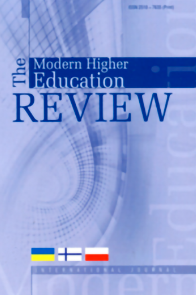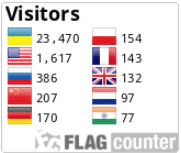UKRAINIAN UNIVERSITY STUDENTS IN CANADA: CULTURAL CAPITAL AND EDUCATIONAL EXPERIENCES
DOI:
https://doi.org/10.28925/2518-7635.2017.2.11Keywords:
cultural capital, immigrant students, literacy, non-visible minorities, post-socialism.Abstract
This qualitative research involving semi-structured interviews with Ukrainian university students in Canada helps to understand their educational experience using the concept of cultural capital put forward by Pierre Bourdieu. It was found that Ukrainian students possess high levels of cultural capital, which provides them with advantage in Canada. Specific patterns of social inequality and state-sponsored obstacles to social reproduction lead to particular ways of acquiring cultural capital in Ukraine represented by a more equitable approach to the availability of print, access to extracurricular activities, and popularity of enriched curriculum. Further research on cultural capital in post-socialist countries is also discussed.
Downloads
References
Asanova, J. (2005). Educational experiences of immigrant students from the former Soviet Union: A case study of an ethnic school in Toronto. Educational Studies, 31(2), 181–195.
Bhattacharya, G. (2011). Is social capital portable? Acculturating experiences of Indian immigrant men in New York City. Journal of Intercultural Studies, 32 (1), 75–90.
Birani, A., & Lehmann, W. (2013). Ethnicity as social capital: Examination of first-generation, ethnic-minority students at a Canadian university. International Studies in Sociology of Education, 23 (4), 281–297.
Bourdieu, P. (1986) ‘The forms of capital’. In J.G. Richarson (Ed.), Handbook of theory and research for the sociology of education. New York, US: Greenwood Press.
Bourdieu, P., & Passeron, J-C. (1977). Reproduction in education, culture, and society. London, UK: Sage.
Broadfoot, T. (1978). Reproduction in education, society and culture. Comparative Education, 14 (1), 75–82.
Cenoz, J. (2012). The influence of bilingualism on third language acquisition: Focus on multilingualism. Language Teaching, 46 (1), 1-16. doi: 10.1017/S0261444811000218
Cilliers, J. (2005). Invisible minority Immigrants and acculturation stress: The moderating effect of adaptiveness on psychological well-being. Unpublished MA thesis, Trinity Western University, Canada, US.
Citizenship and Immigration Canada. (2014). Facts and figures 2013 – Immigration overview: Permanent residents. Retrieved from http://www.cic.gc.ca/english/resources/statistics/facts2013/permanent/10.asp
Citizenship and Education Canada. (2015). Determine your eligibility – Canadian Experience Class. Retrieved from http://www.cic.gc.ca/english/immigrate/cec/apply-who.asp
Cohen, L., Manion, L., & Morrison, K. (2007). Research methods in education (6th edition). London, UK and New York, US: Routledge.
Constantino, R. (2005). Print environments between high and low socioeconomic status (ses) communities. Teacher Librarian, 32(3), 22–25.
Crook, C. (1997). Cultural practices and socioeconomic attainment: The Australian experience. Westport, CT: Greenwood Press.
Cummins, J. (2011). Literacy engagement. Reading Teacher, 65(2), 142–146.
De Graaf, N., & De Graaf, P. (2000). Parental cultural capital and educational attainment in the Netherlands: A refinement of the cultural capital perspective. Sociology of Education, 73(2), 92–111.
Eccles, B., Barber, J., Stone, J., & Hunt, J. (2003). Extracurricular activities and adolescent development. Journal of Social Issues, 59 (4), 865–889.
Evans, M., Kelley, J., Sikora, J., & Treiman, D. (2010). Family scholarly culture and educational success: Books and schooling in 27 nations. Research in Social Stratification and Mobility, 28 (2), 171–197.
Gaztambide-Fernándes, R., Saifer, A, & Desai, C. (2013). ‘Talent` and the misrecognition of social advantage in specialized arts education. Roeper Review, 35, 124–135.
Grayson, P. (2011). Cultural capital and academic achievement of first generation domestic and international students in Canadian universities. British Educational Research Journal, 37(4), 605–630.
Grenfell, M. (2009). Applying Bourdieu's field theory: The case of social capital and education. Education, Knowledge and Economy, 3(1), 17–34.
Harris, A, Jamison, K., & Trujillo, M. (2008). Disparities in the educational success of immigrants: An assessment of the immigrant effects for Asians and Latinos. Annals of the American Academy of Political and Social Science, 620(1), 90–114.
Kaufman, J., & Gabler, J. (2004). Cultural capital and the extracurricular activities of girls and boys in the college attainment process. Poetics, 32(2), 145–168.
Kraaykamp, G., & Eijck, K. (2009). The intergenerational reproduction of cultural capital: A threefold perspective. Social Forces, 89 (1), 209–231.
Lamont, M., & Lareau, A. (1988). Cultural capital: Allusions, gaps and glissandos in recent theoretical developments. Sociological Theory, 6(2), 153-168.
Lareau, A. (2003). Unequal childhoods: Class, race, and family life. Berkeley, CA: University of California Press.
Lee, E., & Kao, G. (2009). Less bang for the buck? Cultural capital and immigrant status effect on kindergarten academic outcomes. Poetics, 37 (3), 201–226.
Lehmann, W. (2007). ‘I just didn’t feel like I fit in’: The role of habitus in university dropout decisions. Canadian Journal of Higher Education, 37(2), 89–110.
Lehmann, W. (2009). University as a vocational education: Working class students’ expectations for university. British Journal of Sociology of Education, 30(2), 137–149.
Lindsay, J. (2010). Children's access to print material and education related outcomes: findings from a meta-analytic review. Retrieved from http://www.rif.org/documents/us/RIFandLearningPointMeta-FullReport.pdf
Moore, R. (2008). Capital. In M. Grenfell (ed.), Pierre Bourdieu: key concepts. Stocksfield, England: Acumen.
Nesteruk, O., Marks, L., & Garrison, B. (2009). Immigrant parents’ concerns regarding their children’s education in the United States. Family and Consumer Sciences Research Journal, 37(4), 422–441.
Notten, N., & Kraaykamp, G. (2010). Parental media socialization and educational attainment: Resource or disadvantage? Research in Social Stratification and Mobility, 28 (4), 453–464.
Organization for Economic Cooperation and Development (OECD). (2014). Education at a glance. OECD indicators. Paris: OECD. Retrieved from http://www.oecd.org/edu/Education-at-a-Glance-2014.pdf
Peng, S., & Wright, D. (1994). Explanation of academic achievement of Asian American students. The Journal of Educational Research, 87(6), 346–352.
Portes, A., & MacLeod, D. (1996). Educational progress of children of immigrants: The roles of class, ethnicity, and school context. Sociology of Education, 69(4), 255–275.
Pristed, B. (2013). Glastnost noire: the Soviet and Post-Soviet publication and reception of James Hadley Chase. Book History, 16 (1), 329–363.
Resnik, J. (2012). The denationalization of education and the expansion of the International Baccalaureate. Comparative Education Review, 56(2), 248–269. doi: 10.1086/661770
Robila, M. (2004). Families in Eastern Europe: Context, trends and variations. In M. Robila (Ed.), Families in Eastern Europe. Amsterdam, Netherlands: Elsevier.
Samuel, E., Krugly-Smolska, E., & Warren, W (2001). Academic achievement of adolescents from selected ethnocultural groups in Canada: A study consistent with John Ogbu's theory. McGill Journal of Education, 36 (1), 61–73.
Satzewich, V., Isajiw, W., & Duvalko, E. (2006). Social networks and the occupational settlement experiences of recent immigrants from Ukraine to Toronto. Journal of Ukrainian Studies, 31(1/2), 1–25.
Smala, S., Paz, J., & Lingard, B. (2013). Languages, cultural capital and school choice: Distinction and second-language immersion programmes. British Journal of Sociology of Education, 34 (3), 373–391.
Statistics Canada. (2006). Ethnic origins, 2006 counts, for Canada, provinces and territories. Retrieved from http://www12.statcan.ca/census-recensement/2006/dp-pd/hlt/97562/pages/page.cfm?
Lang=E&Geo=PR&Code=01&Table=2&Data=Count&StartRec=1&Sort=3&Display=All&CSDFilter=5000
Statistics Canada. (2011a). Immigration and ethnocultural diversity in Canada. Retrieved from http://www12.statcan.gc.ca/nhs-enm/2011/as-sa/99-010-x/99-010-x2011001-eng.cfm
Statistics Canada. (2011b). 2011 National Household Survey; data tables. Retrieved from http://www12.statcan.gc.ca/nhs-enm/2011/dp-pd/dt-td/Rp-eng.cfm?LANG=E&APATH=3&DETAIL=0&DIM=0&FL=A&FREE=0&GC=0&GID=0&GK=0&GRP=1&PID=105411&PRID=0&PTYPE=105277&S=0&SHOWALL=0&SUB=0&Temporal=2013&THEME=95&VID=0&VNAMEE=&VNAMEF
Statistics Canada. (2012). Classification of visible minority. Retrieved from http://www.statcan.gc.ca/concepts/definitions/minority01-minorite01a-eng.htm
Thomas, G. (2011). A typology for the case study in social science following a review of definition, discourse, and structure. Qualitative Inquiry, 17(6), 511–521.
Tromly, B. (2014). Making the Soviet intelligentsia: universities and intellectual life under Stalin and Khrushchev. Cambridge; New York, US: Cambridge University Press.
Wacquant, L. (2008). Pierre Bourdieu. In Rob Stones (ed.), Key sociological thinkers. London, UK and New York, US: Macmillan.
Weenink, D. (2008). Cosmopolitanism as a form of capital: Parents preparing their children for a globalizing world. Sociology: The Journal of the British Sociological Association, 42 (6), 1089–1106.













